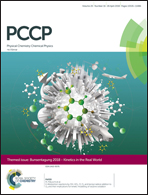Electron-driven spin diffusion supports crossing the diffusion barrier in MAS DNP†
Abstract
Dynamic nuclear polarization (DNP) can be applied to enhance the sensitivity of solid-state NMR experiments by several orders of magnitude due to microwave-driven transfer of spin polarization from unpaired electrons to nuclei. While the underlying quantum mechanical aspects are sufficiently well understood on a microscopic level, the exact description of the large-scale spin dynamics, usually involving hundreds to thousands of nuclear spins per electron, is still lacking consensus. Generally, it is assumed that nuclear hyperpolarization can only be observed on nuclei which do not experience strong influence of the unpaired electrons and thus being significantly removed from the paramagnetic polarizing agents. At the same time, sufficiently strong hyperfine interaction is required for DNP transfer. Therefore, efficient nuclear spin diffusion from the strongly-interacting nuclei to the NMR-observable bulk is considered to be essential for efficient nuclear hyperpolarization. Based on experimental results obtained on the endohedral fullerene N@C60 as a polarizing agent sparsely diluted in C60, we discuss the effect of the spin-diffusion barrier. We introduce electron-driven spin diffusion (EDSD) as a novel mechanism for nuclear polarization transfer in the proximity of an electron spin which is particularly relevant under magic-angle spinning (MAS) DNP conditions.



 Please wait while we load your content...
Please wait while we load your content...